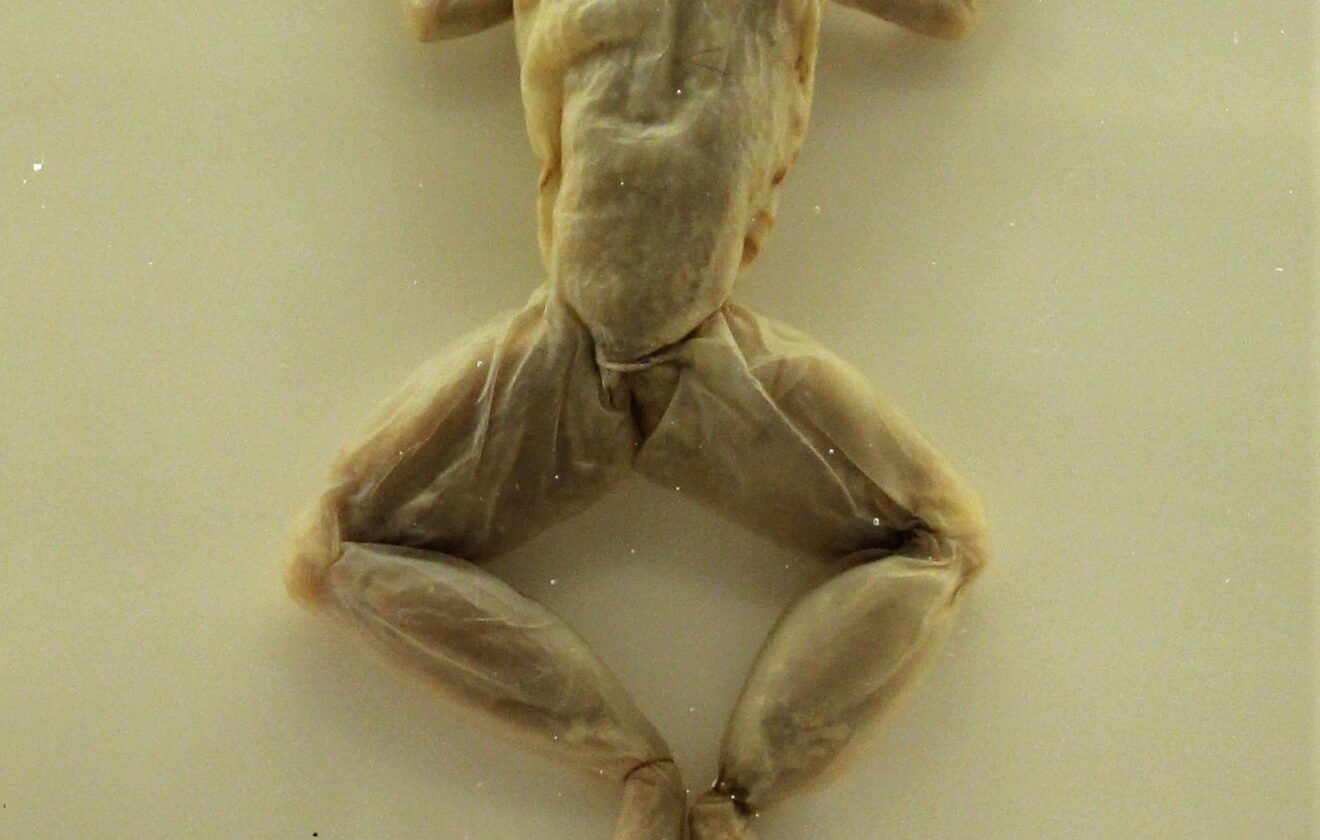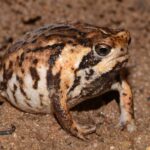- Astylosternus diadematus: Africa's Enigmatic Diademed Frog
- Taxonomy and Classification
- Natural Habitat: A Symphony of Life in Central Africa
- Physical Characteristics: Beautifully Adapted for Rainforest Life
- Behavior and Life Cycle: The Secrets of the Forest Floor
- Ecological Role: Guardians of Biodiversity
- Threats and Conservation Status: A Call for Action
- Cultural and Scientific Significance: Lessons from the Forest
- Conclusion: Preserving a Treasured Ambassador of Biodiversity
Astylosternus diadematus: Africa’s Enigmatic Diademed Frog#
Hidden beneath the lush greenery and melodic symphony of a Central African rainforest, the diademed frog—Astylosternus diadematus—makes its presence known through rhythmic calls and subtle movements within dense leaf litter. Distinguished by its intriguing patterns and quiet charm, this amphibian represents more than just a species within a rich ecosystem. It is a symbol of biodiversity, a measure of environmental health, and, perhaps most significantly, a compelling storyteller of the forests’ intricate and often-hidden worlds.
The name diadematus, meaning “diademed” or “crowned,” aptly describes the delicate markings adorning this frog’s body—nature’s artistic touch fittingly crowning it among Central Africa’s amphibian treasures. But beyond its aesthetic appeal lies a sophisticated blend of adaptation, ecological importance, and pressing conservation concerns deserving deeper exploration.
Taxonomy and Classification#
Classified under the family Arthroleptidae and within the genus Astylosternus, the diademed frog (Astylosternus diadematus) shares ancestry and characteristics with a fascinating lineage of African amphibians collectively known as night frogs. First described scientifically in the late nineteenth century, the species has since become a valuable subject of study due in part to its unique morphological features and distinctive lifestyle.
Within its genus, Astylosternus diadematus is closely related to species such as Astylosternus batesi and Astylosternus laurenti. Together, they occupy similar ecological niches, yet subtle differences in morphology, vocalization, habitat preference, and behavior distinctly separate them.
Natural Habitat: A Symphony of Life in Central Africa#
The enchanting home of Astylosternus diadematus spans the humid, densely vegetated forests of Cameroon, Gabon, Equatorial Guinea, and the Republic of the Congo. Nestled primarily within lowland rainforest ecosystems, the species thrives near clear, slow-moving forest streams and leaf-covered forest floors, environments that offer the necessary moisture, shelter, and abundant prey.
A Mosaic of Microhabitats#
What makes the forest particularly suited for the diademed frog is the diversity of microhabitats it provides—moss-covered logs, sheltered rock crevices, thick leaf litter layers, and streamside banks shaded by towering foliage overhead. Here, humidity rarely drops below saturation point and temperatures remain consistently ideal for amphibians sensitive to environmental fluctuations.
Astylosternus diadematus capitalizes on these extraordinary microhabitats, adeptly using their varied shelter points to evade predators, hunt prey, and reproduce successfully. Within this rich tapestry, they exist seamlessly, moving silently between worlds—invisible guardians and active participants in their ecological niches.
Physical Characteristics: Beautifully Adapted for Rainforest Life#
One glance at Astylosternus diadematus reveals a creature uniquely prepared for life amidst Central Africa’s tangled flora. Adult frogs typically reach lengths of approximately 40–60 millimeters, making them ideally sized to navigate dense forest undergrowth unnoticed.
An Intricate Patterned Camouflage#
Remarkably patterned with shades of olive, pale brown, gold, and subtle green, their coloration provides near-perfect camouflage among wet leaves, shaded soil, and moss-covered rocks. Distinctive dark markings sometimes form shapes reminiscent of elegant crowns or diadems, giving rise to their fitting epithet.
Their skin texture is neither sleek nor rough, but delicately granular—an effective adaptation to their damp environment, facilitating moisture absorption crucial for amphibian dermal respiration. Prominent eyes protrude slightly above their heads, providing a critical vantage point that helps detect threats and locate aerial prey swiftly and silently.
Behavior and Life Cycle: The Secrets of the Forest Floor#
Quiet and predominantly nocturnal, Astylosternus diadematus conceals itself by day, becoming active only as the rainforest dusk settles in. This nightly emergence marks the frog’s most remarkable behavioral period, defined by intriguing courtships, strategic hunts, and delicate interactions.
Feasting Under Moonlight#
Carnivorous by necessity, these frogs feast opportunistically on insects, spiders, small arthropods, and occasionally small invertebrates like earthworms. Agile hunters, they react swiftly, snatching prey with their sticky tongue quickly enough to seem invisible to the human eye—an elegant and effective survival strategy developed over millions of years.
An Enchanting Courtship Chorus#
During rainy seasons, the normally quiet forest echoes with rhythmic calls from male diademed frogs. Each male finds strategic perches on logs, leaves, or low-lying branches near streams to amplify his resonant vocals in search of a mate. Females locate males through distinct acoustic cues, ultimately choosing partners through subtle, yet complex, mating rituals.
Following mating, females deposit strings of jelly-like eggs carefully tucked beneath submerged vegetation, a protective strategy ensuring tadpoles develop hidden from sight and safer from predators. Over ensuing weeks, rich water-borne nutrients foster rapid tadpole growth, eventually leading to metamorphosis and a new wave of young diademed frogs.
Ecological Role: Guardians of Biodiversity#
Natural ecosystems rely heavily on biological diversity, with amphibians like Astylosternus diadematus providing pivotal ecological services. They function both as predator and prey, keeping insect populations balanced, and acting as vital food sources for snakes, large insects, and certain bird species:
Significantly, the diademed frog serves as an ecological indicator species. Sensitive to environmental changes like pollution or habitat degradation, their presence—or lack thereof—often signals broader ecosystem health. Thus, conservationists pay special attention to these creatures, connecting their well-being directly with overall ecosystem integrity.
Threats and Conservation Status: A Call for Action#
Despite their pivotal ecological roles, Astylosternus diadematus populations face escalating threats stemming from habitat alterations, environmental contamination, and climate-induced shifts to their rainforest environments—pressures instinctively testing their resilience.
Habitat Loss & Fragmentation#
The greatest threat arises from habitat loss tied to logging, agriculture expansion, and human settlement encroachment. Such human-driven pressures fragment pristine habitats into patches unsuitable for long-term populations, drastically reducing species stability.
Climate Change Resilience Challenges#
Accelerating climate variations alter rainfall patterns, temperature, humidity balance, and stream regimes—all directly impacting the breeding success and survival rates of this sensitive species. These impacts create ripple effects felt throughout the delicate ecological web of Central African rainforests.
Currently classified as Near Threatened on the IUCN Red List, ongoing population monitoring and habitat protection initiatives are vital to stave off further decline. Collaborative programs engaging researchers, local communities, policymakers, and conservation NGOs stand as a hopeful model to ensure long-term viability of this extraordinary species.
Cultural and Scientific Significance: Lessons from the Forest#
Beyond serving science as indicators of ecological health, frogs like Astylosternus diadematus symbolize renewal and vitality in regional cultural folklore. Local communities often view them as nature’s messengers, whose presence denotes life-giving rains and balanced ecosystems—a cultural reverence aligned closely with modern conservation philosophies.
From a scientific perspective, the diademed frog continually sheds new insights on amphibian biology including habitat specificity, reproductive ecology, and sensitivities to environmental disruptions—all invaluable for global amphibian conservation strategy.
Conclusion: Preserving a Treasured Ambassador of Biodiversity#
In the lush, vibrant rainforests of Central Africa, Astylosternus diadematus remains a quietly magnificent ambassador for amphibian biodiversity and ecosystem integrity. As humans inherently tied to nature’s intricate systems, our responsibility extends beyond simple admiration. Supporting conservation initiatives, raising awareness, and actively protecting habitats ensures future generations may savor the subtle symphonies and secret lives of forest icons like the diademed frog.
Together, through knowledge, active stewardship, and sincere reverence we can sustain these enchanting forest guardians, ensuring that their captivating calls continue echoing beneath mist-filled trees, guiding conservation hearts and ecological minds long into the future.














